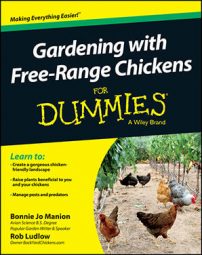If you have more space, perhaps you want a larger flock. Having chickens is addicting — it's common for people to increase their flocks over time with new breeds, adoption, and the tempting visit to the feed store.
Another consideration for chicken flock size is personal egg consumption. Are you a family of eight, all of whom love eggs? Are you not an egg eater at all, but love the idea of chickens in your garden? Are you a bachelor who loves gourmet omelets? Generally speaking, allow two laying hens per person eating eggs. But first pay attention to the space reserved for a chicken coop, an outside pen, and your garden size.
The space you can devote to a chicken coop will tell you how many chickens you can have in your flock. Most people don’t think about space requirements and usually err on the side of having too large a flock for their needs and space. In addition to a chicken coop, you need to determine the square footage you can devote to foraging space.
The minimum rule of thumb is about 2 to 3 square feet per chicken inside the chicken coop, and 8 to 10 square feet per chicken in an outside run. More square footage is better.
Skimping on space requirements for a flock of chickens can cause stress, cannibalism, pecking, and sometimes even death. Cramped living space in a flock invites stress and potential for disease. The best thing you can do to keep a happy and healthy flock is to give it adequate space.Another factor to consider with space requirements is the type of chicken breed you like best. Bantam breeds are considerably smaller chickens than heavy breed chickens, requiring less space than heavy breed or large chickens. Even though Bantam chickens are smaller, they can sometimes lay large eggs relative to their size.
Please note that space requirements can vary depending on your flock age and breeds, climate, season, and management of free-range garden time.
| Breed | Chicken Coop Space Requirement | Outside Pen Space Requirement |
|---|---|---|
| Large Chickens (standard) | 2 square feet per bird | 8 to 10 square feet per bird |
| Bantam Chickens | 1 square foot per bird | 4 square feet per bird |
A rule of thumb for free-range space is 250 to 300 square feet per bird. If you plan to create permanent runs and fencing, use 250 square feet per bird or more.
After you determine how much space you have in your garden for a chicken coop, outside pen, and free-ranging, you can figure out how many chickens you can optimally have. Leave yourself some wiggle room for changes in your flock, such as when your favorite feed store is carrying irresistible day-old chicks.You want to provide a healthy environment for your chickens and a nice balance of space or ecosystem, which allows your garden to flourish. If your flock of chickens has too little garden space to roam in, your garden will have bald spots from over-foraging, visible poop on bare ground, a bad odor, and a problem with flies. Needless to say, none of that is desirable.

